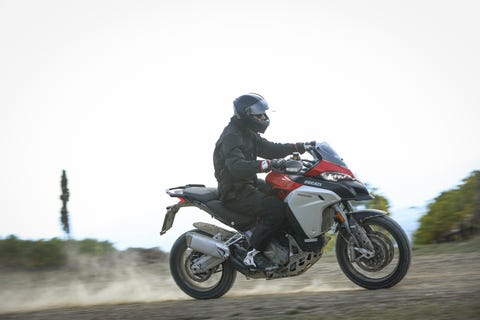Road Test: 2019 Ducati Multistrada 1260 Enduro
The new Ducati Multistrada 1260 Enduro is a serious piece of kit, with updates to last year’s model including a new engine and better rider ergonomics.
What is it?
The standard (non-Enduro) Multistrada by Ducati is a big, high-horsepower adventure-tourer packed with technology. Though its looks and upright riding position conjure images of navigating remote villages, it rides more like a comfortable superbike than a grown-up dirt bike. For proof of the standard bike’s on-road capabilities, watch the Multistrada’s race-winning runs up the paved Pike's Peak course
The Enduro version is for riders who are keen to explore remote areas, and specially tailored to improve off-road capability. It comes with a larger fuel tank, a 19-inch front tire, more suspension travel, and more relaxed frame geometry.
What’s new?

Back in 2015, Ducati upgraded the Multistrada to the glorious 1200 DVT (Desmodromic Variable Timing), eradicating the low-RPM blatter of the non-DVT 1200. But the DVT suffered from a strange lack of torque around 5,000 RPM. The new 1260 engine solves that with an additional 64 cc of displacement and a redesigned collector in the exhaust system. In practice, it pulls strongly from just above idle, all the way to a banzai, 156-hp crescendo. A new up-and-down quickshifter allows clutchless, no-lift upshifts, and auto-blips the throttle during downshifts.
The electronics are state-of-the-art. The same Bosch stability control system from the previous Multi applies ABS when cornering, wheelie control, traction control, and helps the Sachs Skyhook semi-active suspension decide what damping to specify at any given moment. You adjust it through buttons and a color 5-inch display, the older versions of which were tricky to navigate. Thankfully, the new system is much more intuitive. It now displays an infographic alongside each adjustable function to help explain both the effect and whether a given choice improves performance or enhances safety. Riding modes can also be customized in a phone application, then sent to the bike over Bluetooth.
Ducati says customers complained that the previous Enduro felt tall and heavy when riding off road—its seat height was an inch higher than the already-tall base Multistrada. To lower the center of gravity and to make the bike easier to manage, Ducati has decreased the suspension travel by half an inch, to 7.25 inches. To preserve performance in the face of the reduced travel, the desingers changed the semi-active suspension’s damping strategy and installed progressive springs. The system tells the bike to provide extra compression damping when it detects a big impact.
How’s it ride?
The issues of the non-DVT 1200s are long gone. This DVT pulls smoothly and strongly from anywhere in the rev-range, and anyone used to driving cars would be astonished at the performance. It’s got enough juice to make a track-day interesting. In first and second gear, the front wheel will rise into the air with liberal throttle application. In third, it comes up over crests. The larger front wheel is a touch more twitchy than the 17” wheel on the standard Multistrada, but the Enduro’s new steering damper quels any flightiness.
When it’s time to set up for a corner, Radial Brembo 4.32 Monoblock calipers bite big 320mm disks, and provide lots of feel. Squeeze a bit harder and long stoppies aren’t difficult. The Bosch electronics deduce that the back wheel is in the air and adjust the rear shock’s damping to help soften the impact of the big bike coming back to earth.
The upright riding position remains, but the pegs, seat, and bars are all slightly lower than on other Multistradas to make the bike easier to manage at low speed -- the seat is 33.9” high, with optional high and low seats are available. Big cutouts in the fuel tank mean that even tall riders are able to tuck their knees in. It’s comfortable, an ideal position for fast riding on twisty, unfamiliar roads. An adjustable screen keeps the windblast at bay, and heated grips keep your hands warm and dexterous.
Off-road, even with optional Pirelli Scorpion Rally tires, the Enduro won’t rail through the corners like a proper enduro racing bike, but the big front wheel and electronic systems do help the 500+ pound bike cope with rough terrain. The “Enduro” riding mode softens the throttle response and cuts power to 100 bhp for more control over uneven terrain, and the short gearing and fat torque curve means the clutch rarely has to be employed. The ABS works well in loose gravel, at least in a straight line. And the quick-shifter is especially useful here—you can select a lower gear quickly, without losing speed.
The most surprising technological transformation from on-road to off-road is the suspension. It somehow managed to keep the heavy bike under control. I never bottomed out during repeated sharp impacts, and other riders said that the new bike is much better off-road than the old bike. Still heavy enough to be nerve-wracking in slippery mud or on big, loose rocks.
Who’s this for?
With street tires, the 1260 Enduro can be ridden like a sportbike. With knobby tires, it’s is surprisingly capable over rough terrain. It’s the dream package for many: comfortable, off-road ready, and on asphalt, it can hang with sport bikes. As a result, the “Multistrada” name is really suited to this bike.
By Nick Goddard
Check out our inventory of the Ducati Multistrada 1260 Enduro
